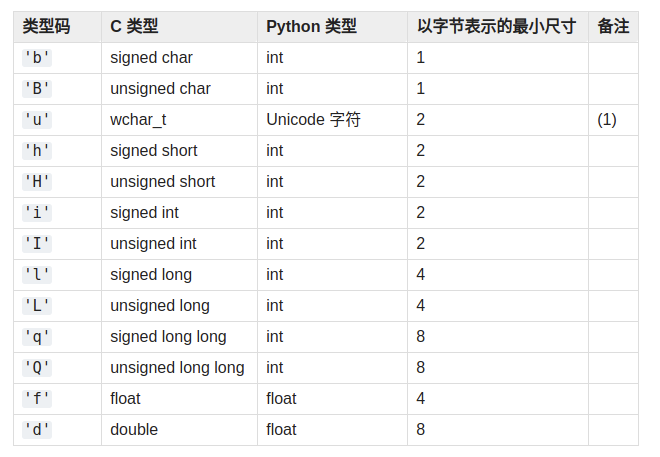一 概念
如果我们需要一个只包含数字的列表,那么array.array比list更高效。数组支持所有跟可变序列有关的操作,包括.pop,.insert和.extend。
另外,数组还提供从文件读取和存入文件的更快的方法,如.frombytes和.tofile。
此模块定义了一种对象类型,可以紧凑地表示基本类型值的数组:字符、整数、浮点数等。 数组属于序列类型,其行为与列表非常相似,不同之处在于其中存储的对象类型是受限的。 类型在对象创建时使用单个字符的类型码来指定。 已定义的类型码如下:

二 内建函数
该模块提供了不少内建函数,具体名字和使用方法如下所示:
append() -- append a new item to the end of the array buffer_info() -- return information giving the current memory info byteswap() -- byteswap all the items of the array count() -- return number of occurrences of an object extend() -- extend array by appending multiple elements from an iterable fromfile() -- read items from a file object fromlist() -- append items from the list frombytes() -- append items from the string index() -- return index of first occurrence of an object insert() -- insert a new item into the array at a provided position pop() -- remove and return item (default last) remove() -- remove first occurrence of an object reverse() -- reverse the order of the items in the array tofile() -- write all items to a file object tolist() -- return the array converted to an ordinary list tobytes() -- return the array converted to a string
三 实例解析
A.创建数组
import array #creating array int_array = array.array('i',[1,2,3,4]) float_array = array.array('f',[1.1,1.2,1.3,1.4]) print(int_array) print(float_array) print(type(int_array))
运行结果:
array('i', [1, 2, 3, 4])
array('f', [1.100000023841858, 1.2000000476837158, 1.2999999523162842, 1.399999976158142])
<class 'array.array'>
2 打印数组
import array int_array = array.array('i',[1,2,3,4]) for icnt in int_array: print(icnt) for icnt in range(0,len(int_array)): print(f'int_array[{icnt}] = {int_array[icnt]}')
输出结果:
1 2 3 4 int_array[0] = 1 int_array[1] = 2 int_array[2] = 3
四 参考文档
|
作者:虚生 出处:https://www.cnblogs.com/dylancao/ 以音频和传感器算法为核心的智能可穿戴产品解决方案提供商 ,提供可穿戴智能软硬件解决方案的设计,开发和咨询服务。 勾搭热线:邮箱:1173496664@qq.com weixin:18019245820 市场技术对接群:347609188 |

|




